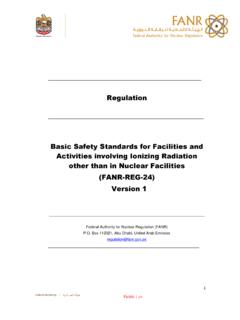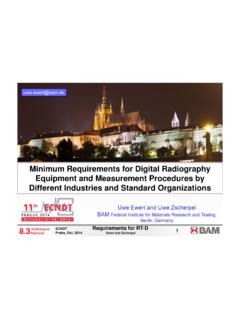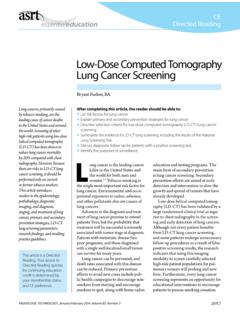Transcription of Radiation Safety (FANR-RG-007)
1 1 _____ Regulatory Guide _____ Radiation Safety (FANR-RG-007) Version 0 24 January 2012 2 Table of Contents Definitions .. 5 Article (1) .. 5 Purpose .. 8 Article (2) .. 8 Exemptions .. 8 Article (3) .. 8 Justification .. 9 Article (4) .. 9 Optimisation of Protection and Safety .. 10 Article (5) ..10 Dose Constraints .. 10 Article (6) ..10 Investigation Levels .. 12 Article (7) ..12 Worker Dose Limits .. 13 Article (8) ..13 Public Dose 14 Article (9) ..14 Protection and Safety Programme .. 15 Article (10) ..15 Safety Assessment .. 16 Article (11) ..16 Potential Exposures .. 17 Article (12) ..17 Radiation Protection Officers .. 18 Article (13) ..18 Training .. 20 Article (14) ..20 Qualified Experts.
2 23 3 Article (15) ..23 Safety Culture .. 23 Article (16) ..23 Manager Training .. 24 Article (17) ..24 Accidents and Incidents .. 24 Article (18) ..24 Accident Prevention .. 25 Article (19) ..25 Use of Gauges .. 25 Article (20) ..25 Evaluation of Overexposures .. 25 Article (21) ..25 Abnormal Circumstances .. 27 Article (22) ..27 Number of Sources That May be Stored in One Place .. 28 Article (23) ..28 Radiation Warning Signs and Labels .. 28 Article (24) ..28 Health Surveillance .. 29 Article (25) ..29 Engineered Controls, Administrative Controls and Personal Protective Equipment .. 30 Article (26) ..30 Controlled and Supervised Areas .. 30 Article (27) ..30 Personal Protective Equipment .. 31 Article (28) ..31 Dosimetry.
3 32 Article (29) ..32 Monitoring, Survey Instruments, and Dosimeters .. 35 4 Article (30) ..35 Worker Compensation for Radiation Exposure .. 39 Article (31) ..39 Releases of Radioactive Material to Sewers .. 39 Article (32) ..39 Pregnant and Breast Feeding Female 40 Article (33) ..40 Medical Quality Assurance .. 41 Article (34) ..41 Decision to Hospitalise or Discharge a 43 Article (35) ..43 References .. 43 Article (36) ..43 5 Basic Principle of Regulatory Guides Regulatory Guides are issued to describe methods and/or criteria acceptable to the Authority for meeting and implementing specific requirements in the Authority regulations. Regulatory Guides are not substitutes for regulations, and compliance with them is not required.
4 Methods of complying with the requirements in regulations different from the guidance set forth by the regulatory guide can be acceptable if the alternatives provide assurance that the requirements are met. Definitions Article (1) For the purposes of this Regulatory Guide, the following terms shall have the meanings set forth below. Activity Concentration The radioactivity per unit mass of a material in which the radionuclides are essentially uniformly distributed. ALARA As Low As Reasonably Achievable Average member of the Critical Group The average of a group of members of the public that is reasonably homogeneous with respect to its exposure to a given Radiation source, and is typical of individuals receiving the highest Effective Dose or Equivalent Dose (as applicable) from the given source Controlled Area A defined area in which specific protective measures or Safety provisions are or could be required for a) controlling normal exposures; b) preventing the spread of contamination during normal working conditions; or c) preventing or limiting the extent of potential exposures.
5 Diagnostic Reference Level A level used in medical imaging to indicate whether, in routine conditions, the dose to the patient or the quantity of Radioactive Material administered in a specified radiological procedure is unusually high or low. Diagnostic Reference Levels are established following consultation with health competent authorities and relevant professional bodies and are based upon surveys or published values appropriate to the circumstances in the State. 6 Dose Constraint A prospective and source-related restriction on the individual Dose from a Radiation Source, which provides a basic level of protection for the most highly exposed individuals from a Radiation Source, and serves as an upper bound on the Dose in Optimisation of protection for that Radiation Source.
6 For Occupational Exposures, the Dose Constraint is a value of individual Dose used to limit the range of options considered in the process of Optimisation. For Public Exposure, the Dose Constraint is an upper bound on the annual Doses that members of the public should receive from the planned Operation of any controlled Radiation Source. Effective Dose The quantity E defined as a summation of the tissue Equivalent Doses, which is each multiplied by the appropriate Tissue Weighting Factor where is the Equivalent Dose in tissue T and is the Tissue Weighting Factor for tissue T. From the definition of Equivalent Dose, it follows that where is the Radiation Weighting Factor for Radiation R and is the average absorbed dose in the organ or tissue External Events Events unconnected with the Operation of a Facility or the conduct of an activity which could have an effect on the Safety of the Facility or activity Incident(s) Any unintended event, including operating errors, equipment failures, initiating events, accident precursors, near misses, or other mishaps, or unauthorised act, malicious or non-malicious, the consequences or potential consequences of which are not negligible from the point of view of protection or Safety .
7 Justification The process of determining whether the conduct or a set of related conducts of a Regulated Activity using Regulated Material is, overall, beneficial; that is, whether the benefits to individuals and to the society from introducing or continuing the conduct or conducts outweigh the resulting harm (including Radiation detriment). THTwRwRTD, T R R T R T w w E , D T T T w E H .. 7 Medical Exposure Exposure incurred by patients for the purpose of medical or dental diagnosis or treatment; by carers and comforters; and by volunteers in a programme of biomedical research involving their exposure Optimisation The process of determining what level of Protection and Safety makes exposures, and the probability and magnitude of potential exposures, as low as reasonably achievable (ALARA) , economic and social factors being taken into account, as required by the International Commission on Radiological Protection System of Radiological Protection.
8 Protection and Safety The protection of people against exposure to Ionising Radiation or Radioactive Material and the Safety of Radiation Sources, including the means for achieving this, and the means for preventing Accidents and for mitigating the consequences of Accidents should they occur. Qualified Expert An individual who, by virtue of certification by appropriate boards or societies, professional licences or academic qualifications and experience, is duly recognised as having expertise in a relevant field of specialisation Radiation Protection Officer A person technically competent in Radiation Protection matters relevant for a given type of Regulated Activity with Regulated Material who is designated by the Licensee to oversee the application of relevant requirements established in this regulation.
9 Safety Culture The assembly of characteristics and attitudes in organisations and individuals which establishes that, as an overriding priority, protection and Safety issues receive the attention warranted by their significance. Supervised Area A defined area not already designated as a Controlled Area but where Occupational Exposure conditions need to be kept under review even though specific protective measures and Safety provisions are not normally needed. Worker(s) Any person(s) who works full-time, part-time or on a temporary basis for a Licensee and who has recognised rights and duties in relation to occupational Radiation Protection. 8 Purpose Article (2) This is a Regulatory Guide to help the Authority s Licensees who possess, use, manufacture, handle, store, transport or dispose of Regulated Material to understand and comply with the Authority s FANR-REG-24, Basic Safety Standards for Facilities and Activities involving Ionising Radiation other than in Nuclear Facilities (Ref.)
10 1). FANR-REG-24 is posted on the Authority s web site, located at Exemptions Article (3) In Article (2) and Schedule 1 of FANR-REG-24, the Authority sets amounts of radioactivity and Activity Concentrations below which the Authority does not regulate. A person that controls larger Activities and Activity Concentrations must have a Licence unless it has been granted an Exemption under Article (5) or (6) of FANR-REG-24. Several specific situations are discussed below. 1. Multiple exempt sources a) A person may have several small sources, each of which is below the limits that the Authority will regulate, but whose total radioactivity exceeds the value in Table 1-1 of Schedule 1 of FANR-REG-24.






